 admin
admin  2021-03-11 09:31:41
2021-03-11 09:31:41
In the past few days, news about electromagnetic touch screens has suddenly increased. It shows that Tongfang Technology has acquired E-person Ebook because of its original handwriting digital writing technology. Later, Samsung is optimistic about Hanwang's electromagnetic touch screen technology and explored the possibility of cooperation. . So what is an electromagnetic screen, what is an electromagnetic touch screen, and what is the principle of an electromagnetic touch screen?

We have compiled some relevant information and released it, hoping to help you understand what an electromagnetic screen is, what is an electromagnetic touch screen, and the principle of an electromagnetic touch screen.
Electromagnetic touch has been around since 1964. It was used for smart digital tablets from the 1970s to the 1980s. Many high-end computer-aided drawing (CAD) systems such as AutoCAD are widely used, and Apple computers were also used as Apple II equipment.
The representative manufacturer of the main electromagnetic technology on the market, the largest Wacom mainly uses its own brand, with revenue of 8.1 billion Taiwan dollars in the first three quarters of 2009, the product price is relatively high, and the resolution can reach 5,000lpi; the company's early It is dedicated to the high-precision CAD/CAM market with drawing functions, and now it also provides 100-inch large-size products. In fact, electromagnetic technology can be used in splicing, so it can be said that there is no size limit at all. N-Trig is a component supplier with the highest cost. Taihan was established in 2004, and the unit cost of the product is low; the cost of the electromagnetic type is lower than 10 inches, and the resistive type has a price advantage if it is less than 10 inches.
Electromagnetic induction touch technology is divided into two categories, one is passive, also known as batteryless pen technology. Wacom dominates the market, and its main patent expires in November 2007; Taihan is the only passive electromagnetic induction touch solution developed in Taiwan Manufacturers. Electric toothbrushes are also similar to passive electromagnetic induction technology, but the electrical conversion is not good and consumes a lot of power. The second is the active type, the pen needs to be inserted into the battery to transmit the signal. The size and weight of the pen are limited by the size of the battery. Except for Wacom, other Taiwanese or American manufacturers are all active technologies. For active electromagnetic sensing, the electromagnetic pen will actively emit electromagnetic signals of a specific frequency to the X/Y-axis antenna array on the tablet, and a metal layer is provided under the tablet.
The electromagnetic pen of passive electromagnetic sensing does not need to install a battery but has a resonance circuit. The tablet transmits an AC electromagnetic field through an antenna. The electromagnetic pen receives the energy of the AC electromagnetic field and stores it, and then the electromagnetic pen transmits an electromagnetic signal back to the tablet; It has a bidirectional antenna with the pen, and there is also a metal layer under the tablet. The disadvantage is that the energy conversion efficiency is lower than 1/200.
Comparing the active type with the passive type, the active type has advantages in terms of power saving, sensing distance, noise, and recording rate, while the passive type has advantages in convenience and pen weight. However, whether the user feels easy to use is the best The key is that passive has the advantages of human-machine interface.
Different from Wacom's passive solution which uses the variable capacitor principle, Taihan uses variable inductance, does not require an additional DC voltage regulator, and does not require a modulation IC, and uses a pen tip to push the iron powder core, using enameled multiple strands Copper wire, there are 2 ferromagnetic cores in the pen, and the working frequency is about 375KHz, which changes with pressure.
Which is better, electromagnetic screen, resistive screen, or capacitive screen?
Compared with resistive and capacitive screens, the transmittance of electromagnetic handwriting touch can reach 100%, and the resistance or capacitance is about 80~90%; the electromagnetic type is rear-mounted and has a mouse function, which is suitable for Windows architecture. The interface, high resolution, Palm Rejection anti-mistouch function, 1024-step pressure sensitivity function, low system integration cost, fast response speed, and unlike resistance and capacitive type that encounter bottlenecks in large-scale development and cost too much , The electromagnetic stand-alone machine has achieved 100 inches.
From the perspective of size and price, electromagnetic type is just the opposite of resistance and capacitive type. The larger the size, the lower the unit cost. The larger the size of the resistance or capacitive type, the higher the unit cost. In general, 8 to 10 inches or less Resistive or capacitive type has advantages, while electromagnetic type has a price advantage over 8 to 10 inches.
Electromagnetic touch screen application market
The main application markets for electromagnetic touch include pen tablets that use the most USB interfaces, tablet displays commonly used in the education market, electronic whiteboards that are growing in the Asian market, signature pads for e-commerce, POS, and electronics that add handwriting capabilities. Book readers, Samsung products have built-in electromagnetic sensing modules, which can provide note-taking, notepad functions, Tablet PC, and Tablet&Book. E-book readers are considered to be a rapidly growing market in recent years, and the trend towards flexible displays is obvious. The electromagnetic touch module has flexible characteristics and can be used with a flexible display; although the need to use a pen is considered a disadvantage, the pen size is small and can be integrated into the system.
Taihan estimates that the potential market for electromagnetic touch technology is estimated to be the most eye-catching growth in e-books and Tablet PCs, with nearly multiple growth from 2010 to 2012, and total shipments are expected to grow from 9.9 million in 2010 to 2011 14.7 million, reaching 24.8 million in 2012. Taihan currently has 117 patents and possesses core technical advantages.